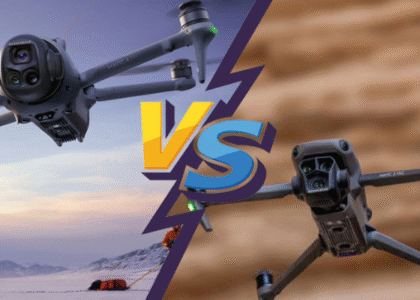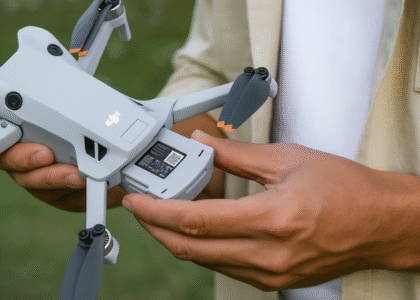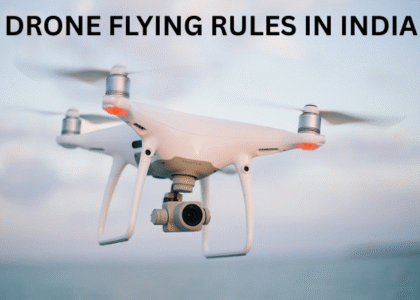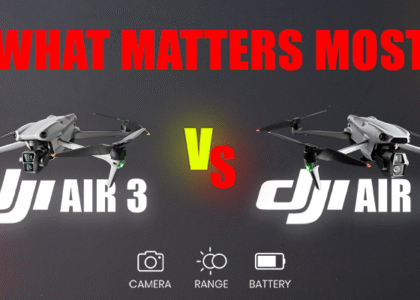Have you ever struggled to choose the perfect drone for your needs be it cinematic videography, precision agriculture, or industrial inspections? With an overwhelming array of options from brands like DJI and Autel, it’s easy to feel lost.
In today’s fast-evolving drone industry, selecting the right platform isn’t about specifications, it’s about matching capabilities to real-world demands and regulations. This guide cuts through the noise, offering you an authoritative roadmap to the best drones to buy in 2025.
Our Top Drone Recommendations for 2025
1. DJI Mini 3 Pro Fly More Combo
The DJI Mini 3 Pro is the ideal entry point into professional aerial photography and videography. Weighing under 250 g, this sub-registration threshold drone features a 1/1.3″ CMOS sensor capable of capturing 48 MP still images and 4K video at 60 fps. Its f/1.7 aperture lens ensures excellent low-light performance, and the 3-axis mechanical gimbal stabilizes footage even in moderately windy conditions. The tri-directional obstacle sensing system makes it highly secure for new pilots, while intelligent flight modes like FocusTrack, MasterShots, and Hyperlapse enhance creative capabilities.
The Fly More Combo elevates the experience further by including three Intelligent Flight Batteries, a 3-bay charging hub, ND filters, and a shoulder bag. This setup extends operational capacity, making it ideal for long-form travel content, real estate walkthroughs, and quick-deploy survey work in remote regions.
Despite its compact frame, the Mini 3 Pro supports DJI’s O3 video transmission system, offering crisp 1080p live feeds over distances up to 12 km. For those seeking professional-grade results in a portable, regulation-friendly format, this drone is a versatile standout.
2. DJI Air 3
The DJI Air 3 blends versatility with precision by featuring a dual-camera system: one wide-angle (24 mm equivalent) and one medium telephoto (70 mm equivalent), both 1/1.3″ CMOS sensors delivering 48 MP photos and 4K video.
This setup enables dynamic focal length switching mid-flight, a powerful tool for creators needing cinematic variety without post-production cropping. With a max flight time of 46 minutes and O4 transmission supporting up to 32 km, the Air 3 is capable of covering large areas with high reliability.
Designed for semi-professional to professional users, the Air 3 includes omnidirectional obstacle sensing and intelligent flight modes like ActiveTrack 5.0, QuickShots, and Waypoint Flight.
It supports 10-bit D-Log M and HLG color profiles, enabling precise color grading in post. Whether you’re filming architectural marvels in an urban jungle or capturing wildlife across India’s grasslands, the Air 3 delivers power, range, and creative control, all in a foldable design that fits neatly into a medium-sized gear bag.
3. DJI Flip Drone
Compact and innovative, the DJI Flip Drone introduces a unique foldable arm design, allowing it to collapse into a pocket-sized cube. Despite its miniature stature, it features a 1/2.3″ CMOS sensor that captures stabilized 4K video at 30 to 60 fps and 12 MP stills.
A 3-axis gimbal ensures buttery-smooth footage, while built-in prop guards and a single-button launch system make it accessible even for absolute beginners. The Flip is an engineering feat targeted at casual users, content creators, and tech enthusiasts looking for a seamless and portable drone solution.
The DJI Flip’s agility is matched by its transmission system, leveraging a simplified version of DJI’s O4 protocol for clean, real-time video. With a flight time of approximately 30 minutes, it’s perfectly suited for quick, high-impact shoots in constrained environments like alleys, apartments, or busy markets. Its combination of compactness, ease of use, and reliable imaging makes it a powerful tool for mobile journalists, YouTubers, and hobbyists who need to shoot, edit, and publish on the go.
4. DJI Mavic 3 Cine Drone Fly More Combo
Designed for elite cinematography, the DJI Mavic 3 Cine combines raw imaging power with professional workflow efficiency. It boasts a dual-camera array: a 4/3″ Hasselblad L2D-20c wide-angle sensor and a 162 mm equivalent telephoto lens.
This setup enables hybrid zoom capabilities and dynamic storytelling in 5.1K Apple ProRes HQ, recorded directly to an integrated 1 TB SSD. The wide-angle lens captures a 12-bit color depth in D-Log, offering unprecedented detail and dynamic range for color grading and compositing in post.
The Fly More Combo enhances utility by including extra Intelligent Flight Batteries, ND filters (ND4–512), a 65W portable charger, and the DJI RC Pro controller with a built-in screen. With a max flight time of up to 46 minutes and omnidirectional obstacle avoidance, it supports demanding aerial shoots across diverse terrains from high-altitude cinematic captures to low-sweep tracking shots. Filmmakers, production studios, and creative professionals regard it as a mobile yet high-performance platform that meets broadcast-quality requirements.
5. DJI Mavic 4 Pro
The DJI Mavic 4 Pro represents the apex of portable aerial imaging for 2025. Its triple-camera system includes a 100 MP Hasselblad wide-angle lens, a 48 MP medium telephoto lens, and a 50 MP ultra-tele lens. Together, they enable triple-focal-length coverage without compromise, ideal for filmmakers who demand flexibility and precision in composition.
These cameras support advanced shooting modes such as DCI 4K at 120 fps, H.265 compression, and real-time HDR previewing, empowering professionals to capture footage suitable for high-end documentary and commercial work.
This drone also features improved wind resistance, AI obstacle avoidance powered by onboard neural processors, and a more refined O4+ video transmission system for seamless live monitoring.
With a maximum flight time of 51 minutes and intelligent flight planning, it’s ideal for time-sensitive projects that require multiple perspectives in a single session. Its modular payload and expanded internal storage options make it a future-ready platform for cinematic, industrial, and hybrid operations.
6. DJI Mavic 3 Enterprise
Built specifically for commercial missions, the DJI Mavic 3 Enterprise transforms the popular Mavic 3 platform into a multi-role industrial asset. It offers two main payload options: a 20 MP 4/3” CMOS wide-angle camera and a 48 MP 1/2” telephoto lens.
These are optimized for surveying, infrastructure inspection, and security patrols. The platform also supports modular accessories like an RTK module for precision georeferencing, a loudspeaker for public announcements, and a spotlight for night operations.
The drone features advanced GPS and RTK integration, enabling centimeter-level accuracy, a necessity for sectors like civil engineering, agriculture, and utilities. Its smart flight modes include real-time mapping and automated waypoint inspection.
With a flight endurance of 45 minutes, enhanced obstacle sensing, and compatibility with enterprise-grade mission software, the Mavic 3 Enterprise is a reliable solution for data-driven industries requiring mobility, safety, and fast deployment.
7. DJI Matrice 300 RTK
A true industrial titan, the DJI Matrice 300 RTK is engineered for mission-critical operations such as utility inspection, public safety, search and rescue, and surveying. It supports up to three payloads simultaneously, including high-end sensors like the Zenmuse H20T, L1 LiDAR, or P1 photogrammetry module. The drone’s IP45 rating and self-heating batteries ensure operability in rain, snow, or extreme heat, while triple-redundant systems protect against communication or hardware failure.
The Matrice 300’s onboard AI features like automated defect detection and subject tracking, which significantly enhance situational awareness and reduce operator fatigue.
RTK and TimeSync technologies enable sub-centimeter mapping accuracy, while its 55-minute flight time supports extensive operations without frequent returns. With hot-swappable dual batteries, a smart controller, and built-in ADS-B air traffic reception, the M300 RTK is the gold standard for enterprise-level UAV integration.
8. Autel EVO Nano+
The Autel EVO Nano+ redefines what’s possible in a sub-250 g drone. Despite its compact build, it features a 1/1.28” CMOS sensor that captures 50 MP photos and 4K/30 fps video in HDR. The RYYB color filter array improves low-light performance by 40%, and its Phase Detection Autofocus (PDAF) technology ensures tack-sharp images even while tracking moving subjects. Intelligent modes like Dynamic Tracking 2.1 and SkyPortrait make it highly user-friendly, perfect for creators who want professional results from a pocket-sized drone.
Flight time is rated at 28 minutes, and the proprietary SkyLink transmission supports smooth HD video up to 10 km. The EVO Nano+ also includes obstacle sensors on the front, rear, and bottom, uncommon in its weight class. For on-the-go professionals, journalists, and social content producers, it delivers unmatched imaging capabilities in a form factor that bypasses most regulatory hurdles.
9. Autel EVO II Pro V3
The Autel EVO II Pro V3 is a rugged, professional drone designed for serious imaging workflows. It houses a 1” CMOS sensor capable of 20 MP stills and up to 6K/30 fps video. With 12-bit RAW recording and HDR video capabilities, it excels in capturing dynamic scenes with rich tonal range and color depth.
Its f/2.8–f/11 adjustable aperture provides full creative control over exposure and depth of field, while omnidirectional obstacle sensing ensures safe navigation in complex environments.
SkyLink 2.0 technology extends transmission to 15 km with ultra-low latency. This drone is also equipped with an open SDK platform, making it highly customizable for use cases in agriculture (NDVI imaging), inspection, and 3D mapping.
The Smart Controller SE’s 6.4” OLED touchscreen allows for bright, clear mission planning even under direct sunlight. Built for professionals who demand flexibility, data integrity, and operational endurance, the EVO II Pro V3 is a standout in the Autel ecosystem.
Comparative Drone Chart
| Model | Sensor | Max Flight Time | Key Features |
| DJI Mini 3 Pro Fly More Kit Plus | 1/1.3″, 48 MP | 34 mins | Sub-250 g, tri-directional sensing |
| DJI Air 3 | Dual 24 mm & 70 mm, 48 MP | 46 mins | Mid-air camera switching |
| DJI Flip Drone | 1/2.3″, 12 MP | 30 mins | Ultra-compact foldable design |
| DJI Mavic 3 Cine Fly More Combo | 4/3″ + 162 mm telephoto | 46 mins | Apple ProRes, 1 TB SSD |
| DJI Mavic 4 Pro | Triple-lens array | 45 mins | 3× sensor versatility |
| DJI Mavic 3 Enterprise | 4/3″ wide + zoom payload | 45 mins | Thermal & zoom payloads |
| DJI Matrice 300 RTK | RTK-enabled, multi-payload | 55 mins | Industrial-grade ruggedness |
| Autel EVO Nano+ | 1/1.28″, 50 MP | 28 mins | Lightweight, HDR modes |
| Autel EVO II Pro V3 | 1″, 20 MP | 40 mins | Open SDK, NDVI mapping |
Choose with Confidence, Fly with Purpose
In 2025, the drone market continues to evolve at an extraordinary pace blending AI, optics, and aerospace-grade engineering into every new model. Whether you’re a real estate developer seeking crisp aerial surveys, a filmmaker pursuing cinematic precision, or a field engineer demanding RTK-level accuracy, there’s no one-size-fits-all.
The key is understanding the nuances like sensor type, transmission range, payload support, and post-processing flexibility to choose the drone that aligns with your mission, budget, and skill level.
Our curated selection of DJI and Autel drones ensures that both enthusiasts and professionals have access to globally trusted technology, backed by local expertise. From ultra-light DJI Mini drones to the modular robustness of the Matrice 300 RTK, every platform comes with tailored support, genuine warranties, and optional hands-on training. As your aerial ambitions grow from cinematic storytelling to precision inspections, FlyandTech is more than a seller, we are a strategic partner in your drone journey.
To explore, test, or train with these models, connect with us on Instagram. Our in-house experts can help you compare features in real time, troubleshoot deployments, and even arrange demo flights tailored to your industry needs.
Frequently Asked Questions
1. What factors influence flight time in professional drones?
A. Flight time depends on battery capacity, payload weight, environmental conditions, and flight profile (hovering vs. cruising). Upgrading to high-capacity batteries can net an extra 10 to 15 minutes.
2. Can I use consumer-grade drones like DJI Mini 4 for industrial inspections?
A. While lightweight DJI Mini drones excel in portability and affordability, their smaller sensors and limited obstacle avoidance make them less suited for complex industrial tasks compared to pro models.
3. Which drone is best for professional filmmaking in 2025?
A. The DJI Mavic 3 Cine is the top choice, offering dual Hasselblad cameras and Apple ProRes recording for seamless post-production.







